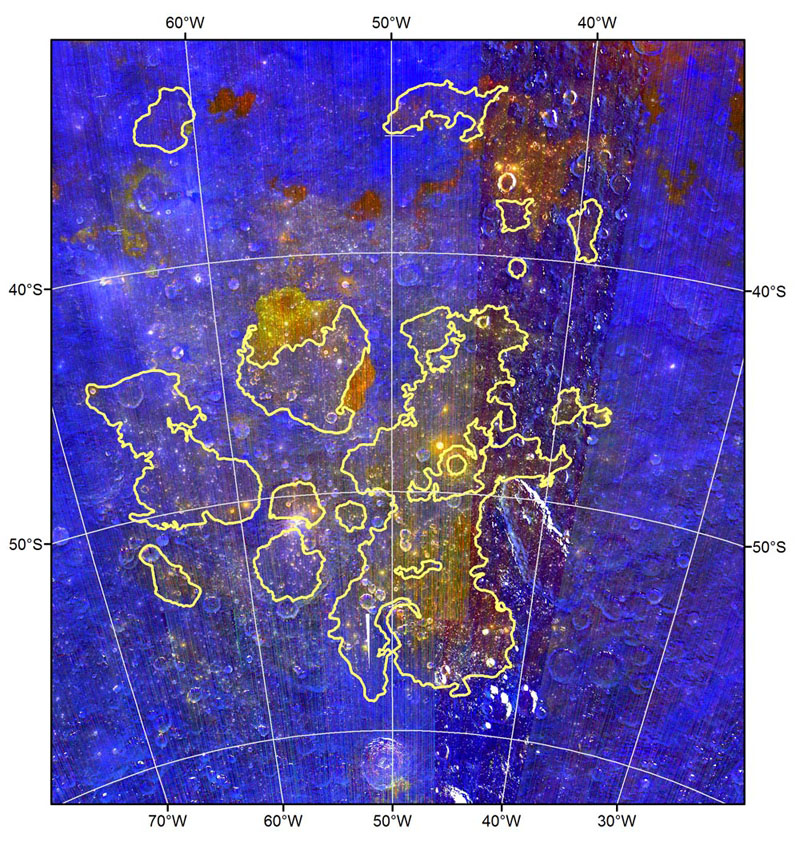
“Volcanic deposits are important because you get a picture of how the surface has been modified, but you can also learn so much about the interior of a planet,” said Jennifer Whitten, who will receive her Ph.D. this week from the Department of Geological Sciences. “So you get a picture of the inside and the outside.”
For her dissertation, Whitten studied volcanic deposits on the Moon and Mercury that date back billions of years. She hopes that a better understanding of these ancient deposits will shed light on the formation and early evolution of those two planetary bodies.
It might also deepen our understanding of Earth in its infancy. On our home planet, ancient volcanic deposits are often ground away by the constant churning of tectonic plates. So to truly understand how volcanism shapes a young planet, Whitten says, it’s essential to look beyond the Earth.
“One of the most perplexing questions about the earliest history of the planets, including Earth, is the amount of volcanic activity that occurs then,” said Jim Head, professor of geological sciences and Whitten’s adviser. “The observational techniques Jennifer Whitten has developed have contributed greatly to our understanding of these early volcanic processes.”
Hidden volcanoes on the Moon and Mercury
On the Moon, some volcanic deposits are easy to spot. The lunar maria — the dark splotches that form the iconic “man in the Moon” — are composed largely of volcanic basalts. Termed “mare,” the Greek word for sea, because early astronomers mistook them for bodies of water, they were formed billions of years ago when molten lava flowed up from the depths and filled in deep basins formed by asteroids and other impactors.

Whitten used a variety of techniques to look through the veneer of impact debris and definitively identify cryptomaria deposits on the Moon. One of those techniques involved looking for a very specific type of crater. When a small impactor strikes a cryptomare deposit, it digs up some of the volcanic material beneath the impact debris. The result is a crater surrounded by a dark halo of mare material.
Using these dark-halo craters as a guide, Whitten was able to identify 18 deposits of cryptomaria on the Moon. Having mapped the deposits, she was able to answer some critical questions about them.
First, she was able to use data from the Moon Mineralogy Mapper, which flew aboard India’s Chandrayaan-1 spacecraft, to identify the composition of the deposits. She found that cryptomaria had a composition similar to the visible maria — something that had been the subject of speculation before now.
“I’ve been able to show that it is actually mare basalt,” she said. “We can use the term cryptomaria and know that it means what we think it means.”
Second, Whitten was able to show that cryptomaria are concentrated on the Moon’s near side — the side facing Earth. It’s long been known that the lunar far side lacks the visible mare deposits that dominate the near side. But it wasn’t clear whether or not there may have been some cryptomaria hiding on the far side.
“Secretly I really wanted to find some major deposit on the far side so I could say, ‘Look everyone; it’s not all on the near side,’” Whitten said. “But that didn’t happen.”
The finding suggests that volcanism throughout the Moon’s history was concentrated on the near side. That appears to be in part because the crust is thinner on the nearside, allowing volcanic material to flow through more easily.
Whitten used similar techniques to look for signs of ancient volcanism on Mercury. There, she was able to show vast areas of the planet’s northern hemisphere, known as the intercrater plains, have a volcanic origin. The work added substantially to the inventory of volcanic material on the surface of Mercury.
More research ahead
Recently, Whitten accepted a position as a postdoctoral researcher at the Smithsonian Air and Space Museum in Washington, D.C. There, she’ll be involved a project that uses radar to look for more buried volcanic deposits on the Moon.
“I’m excited about learning a new technique that provides access to the few upper meters of the lunar surface, especially since my dissertation was focused on finding buried volcanic deposits,” she said. “I am optimistic about finding interesting volcanic features.”
Those features could help deepen our understanding of the solar system.
“In the big picture, understanding volcanic deposits can give a sense of the initial composition of these planets,” Whitten said. “That tells you about the materials in the cloud that formed the solar system.”
It also helps us learn about our own planet. The types of deposits Whitten looked at on the Moon and Mercury are called large igneous provinces or LIPs. LIPs have been fairly common throughout Earth’s history and have been linked to several major extinction events. So understanding how they work could be of critical importance.
“The LIPs on Earth have been eroded or are under the ocean, so it’s hard to study them,” Whitten said. “But you can get an idea of the size of these things and what affects their size because we can study them on Moon or Mercury. I think it’s really exciting that by understanding what’s happening on the Moon and Mercury, you can better understand the early history of the Earth.”
